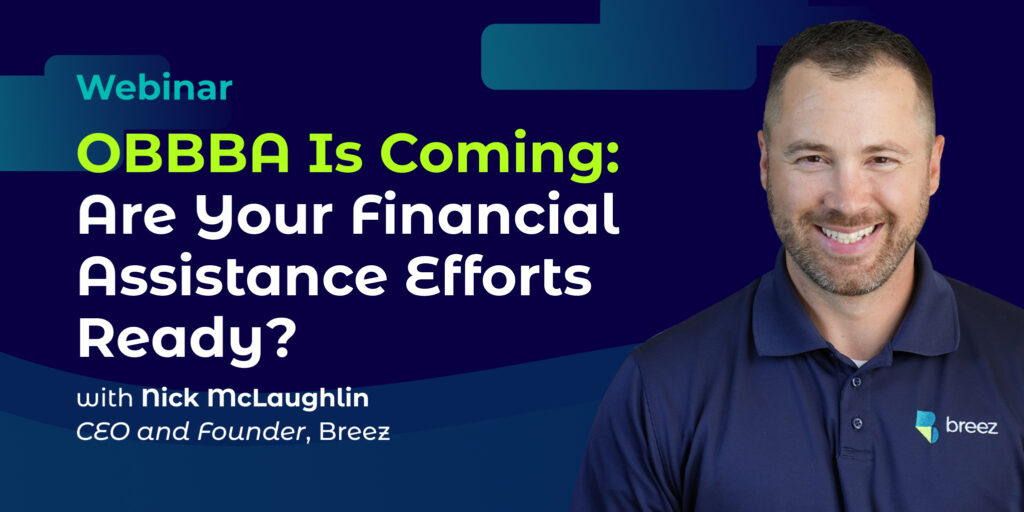By Nick McLaughlin, Founder and CEO of Breez Health
On a busy Tuesday, your ED fills with familiar faces. A diabetic patient who’s been stable for years is suddenly in crisis. A young mom is back with her child’s asthma attack. A retiree arrives with chest pain after skipping medications. None of them wanted to wait this long to seek care. Their coverage slipped—paperwork missed, income verified late, an eligibility quirk—and they waited until symptoms forced their hand.
This is the reality of coverage churn. And OBBBA—the One Big Beautiful Bill Act (OBBBA)—will push it further into the foreground. For hospitals already playing financial and operational triage, OBBBA isn’t just another policy update. It’s a stress test of your financial clearance model, your staffing, and your ability to maintain patient confidence under scrutiny.
Medicaid Redeterminations and Coverage Churn: The Hidden Strain on Hospital Revenue
Over the next decade, federal support for Medicaid tightens, marketplace subsidies roll back, and redeterminations happen more often. Patients bounce in and out of eligibility. On paper, that looks like routine administration. In practice, it looks like skipped doctor’s visits and ED admissions that should have been primary-care encounters.
Hospitals take the hit twice.
First, when coverage lapses and services go unpaid. Second, when untreated issues become acute and expensive. Meanwhile, the administrative load creeps upward: more calls, more forms, more verifications, more appeals—often landing on financial assistance teams already stretched thin.
OBBBA and the End of Reactive Financial Assistance: How Hospitals Must Adapt
For years, many organizations relied on a reactive model: help the uninsured and help the insured when they ask. It made sense when churn was a blip. But churn is becoming the pattern.
Many hospitals still depend on patients to come forward for assistance, but the new mandate is proactive. Identify risk before coverage lapses. Reach out before a bill is missed. Screen upstream, not after the fact. That shift is good for patients and essential for margins—but it’s not feasible if your financial assistance teams are still buried in paper packets, piecing together income proofs, and chasing missing documents.
How to Modernize Financial Assistance Under OBBBA
The right workflows free staff for higher-value work, deliver faster, more defensible determinations, and make screening a seamless part of the care journey.
Here’s how to get there without a massive overhaul:
-
Start with the policy.
If your Financial Assistance Policy is outdated or has so many discount tiers that no two financial counselors decide the same way, simplify. Most high-functioning teams operate with two or three clear tiers, transparent criteria, and documentation standards designed for digital, not filing cabinets. Consistency isn’t just tidy. It’s audit protection.
-
Digitize the front end.
Mobile-first applications let patients submit in minutes—snapping photos of documents, signing on their phones, and getting clear next steps. The team’s role shifts from paper-chase to problem-solve: coaching the tough cases and closing gaps that software can’t.
-
Automate what’s repeatable
Automated, policy-driven reviews, anchored in verified income data and clear eligibility logic, can resolve most applications consistently and in minutes. When technology handles the repeatable checks and document verification, about five out of six cases can be completed without manual intervention. That doesn’t replace your team—it protects them. Counselors spend their time where it matters most: on the 15% of cases that truly require judgment, empathy and persistence.
-
Move upstream
Don’t wait for missed payments or denials to trigger screening. Offer it at registration, include it on statements, text it after discharge. When financial assistance is easy to start, more eligible patients use it, before coverage lapses become write-offs.
Hospitals that have made this shift tend to describe similar outcomes: backlogs disappear, turnaround times shrink, and audits go more smoothly because determinations are numeric, consistent and well documented. Staff report less burnout. Patients describe the process as clear, respectful and—most importantly—worth engaging with.
OBBBA and the Future of Hospital Financial Assistance: Equity as Strategy
The patients most likely to lose coverage are often the least likely to be reached by traditional processes. Language barriers, limited health literacy and mistrust of institutions turn what should be a safety net into another point of friction. True equity means meeting people where they are: on their phones, in their language, with steps that make sense.
The urgency is now. OBBBA won’t only create new strains. It will expose what’s already unsustainable—paper-first workflows, team overload, and processes that miss the very patients they’re meant to help. Modernizing financial assistance isn’t choosing between compliance and compassion. It’s how hospitals achieve both: faster determinations, fewer write-offs, stronger trust, and teams that can focus on care, not paperwork.
OBBBA isn’t a storm to weather—it’s an opportunity to lead. Hospitals that embed equity into design and automation into operations will set the new standard for financial assistance: accessible, defensible, and deeply human.



